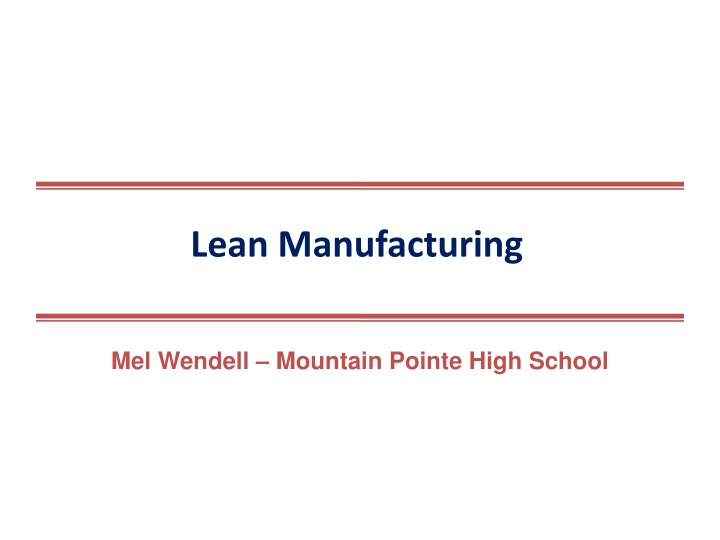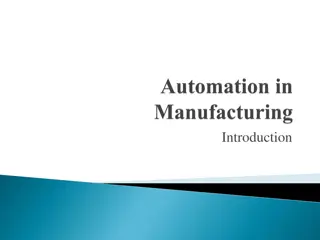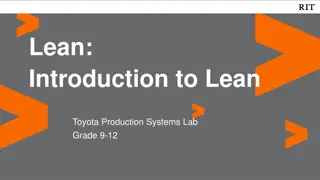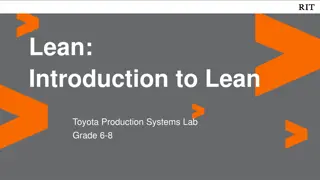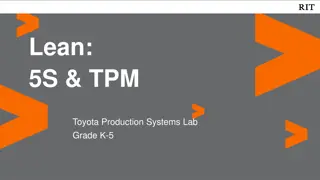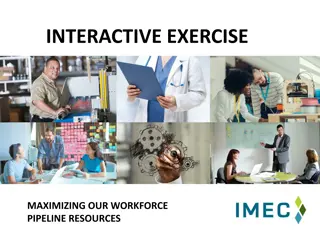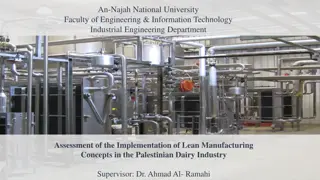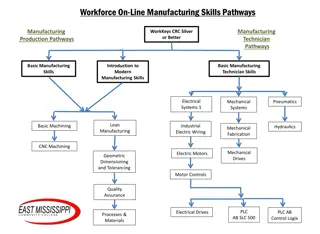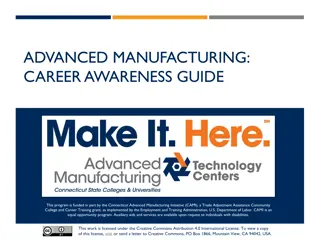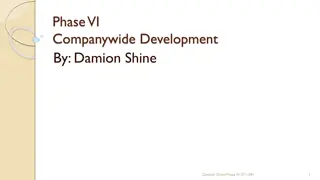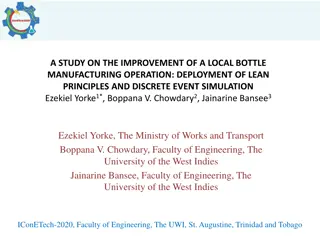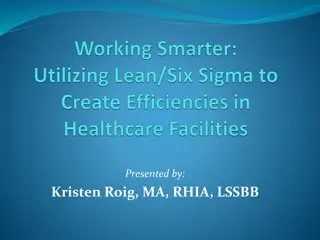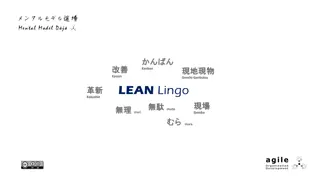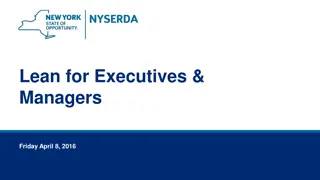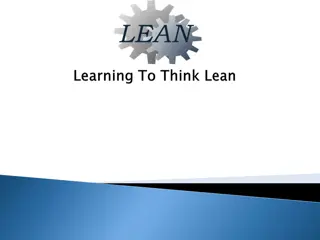Introduction to Lean Manufacturing Principles and Practices
Explore the fundamentals of Lean Manufacturing through a simulation-based course agenda at Mountain Pointe High School. From identifying value-added activities to eliminating waste, learn how to optimize processes to deliver value to customers efficiently. Dive into Lean principles, value stream mapping, and more to streamline operations and enhance quality.
Download Presentation

Please find below an Image/Link to download the presentation.
The content on the website is provided AS IS for your information and personal use only. It may not be sold, licensed, or shared on other websites without obtaining consent from the author.If you encounter any issues during the download, it is possible that the publisher has removed the file from their server.
You are allowed to download the files provided on this website for personal or commercial use, subject to the condition that they are used lawfully. All files are the property of their respective owners.
The content on the website is provided AS IS for your information and personal use only. It may not be sold, licensed, or shared on other websites without obtaining consent from the author.
E N D
Presentation Transcript
Lean Manufacturing Mel Wendell Mountain Pointe High School
Course Agenda Welcome and Background Information 1st round of Simulation (ENGR Catamaran) Lean Manufacturing Lean Principles 2nd round of Simulation (ENGR Catamaran) Lean Manufacturing Building Blocks Closure
Round 1: ENGR CATAMARAN Welcome Team Introductions and Company Names Departments Hull Assembly (2) Rudder and Sail Joint Assembly (2) Sail Assembly (1) Final Assembly (1) Quality Control (1) Goals 3 Catamarans in 9 minutes 100 % Quality Discussion (#) Recommended students per group.
Lean A systematic approach to identifying and eliminating waste (non value-added activities) through continuous improvements by flowing the product at the pull of the customer in pursuit of perfect. In Other Words: Give the customer what they want, when they want it and don t waste anything.
Identify Value Value-Added (5%) Any activity that changes the form or function of the product. Ex Machining, Fab, Assembly, Molding 1) Done right the first time. (Quality & Delivery) 2) Activities the customer is willing to pay for. 3)
Identify Value Non Value-Added (95%) Any activity that does not change form or function or is not necessary. Ex Sales, Production Control, Purchasing, HR, Shipping/Receiving, QC, Accounting, etc. 1) These activities should be eliminated, simplified, reduced, or integrated. 2)
Identify Value Non Value-Added BUT Necessary Any activity that does not change form or function BUT is necessary. Ex: cleaning/packaging, debur, inspection, etc. 1) These activities should be simplified, reduced, or integrated. 2)
Waste = Non Value Added Waste is anything other than the minimum amount of equipment, materials,parts, space, and worker s time which are absolutely essential to add value to the product. - Shoichiro Toyoda President, Toyota
Why Focus on Waste ? Waste is a symptom signaling Time & Money is trapped in the process Waste is a systemic flaw affecting people, materials, machines, and/or information Recognizing waste can lead to identifying the root cause of problems and saving Time & Money
Lean = Eliminating Waste 1. Defects 2. Overproduction of work in process 3. Waiting 4. Non value-added processing 5. Transportation of materials & equipment 6. Inventory Excesses 7. Motion 8. Employees Underutilized Typically, 95% of all lead time is non value added!
Motion Any movement of people or machines that does not add value to the product or service Causes of motion waste: Dis-organized work space Inconsistent work methods Inefficient facility or cell layout Insufficient training or supervision Searching Inadequate tools or supplies at workstation How long would you look?
Organization Limits waste of motion Better
Creating Flow Linking of manual and machine operations into the most efficient combination to maximize value-added content while minimizing waste Hull Rudder & Sail Joint Final Sail
Step 1: Group Products Processing Steps Rudder & Sail Joint Hull Steering Sail Test Catamaran Sail Boat Products with similar processing requirements are grouped into product families
Step 2: Establish Cycle Time Demand = Customer order or Production order Work Time = Quoted or Established production time Work Time Demand Cycle Time = 9 min Cycle Time = 3 catamarans=3 min/catamaran Goal: Produce to Demand
Step 3: Review Work Sequence Observe sequence of tasks each worker performs Break operations into observable elements Identify value-added versus non-value-added. Eliminate or minimize non-value-added Study machine capacity, cycle times and changeover times Round 1 Sequence Times Hull Rudder & Sail Joint Sail Final Assembly Inspection 120 sec 75 sec 30 sec 20 sec 20 sec
Step 4: Combine Work / Balance Process Balanced Line Unbalanced Line Traditional Manufacturing Lean Manufacturing 120 80 70 100 60 80 50 Time Time 60 40 30 40 20 20 10 0 0 Parts Parts Cycle Time = 3 min
Round 2: ENGR CATAMARAN Departments Hull Assembly (3) Rudder and Sail Joint Assembly (2) Sail Assembly (1) Quality Control (1) Goals 3 Catamarans in 9 minutes 100 % Quality Discussion
Lean Building Blocks Continuous Improvement Pull / Kanban Cellular/Flow Batch Reduction Value Stream Mapping Quality at Source Quick Changeover POUS Visual 5S System Standardized Work
Questions? Presenter: Melissa Wendell Session Name: Lean Manufacturing E-mail: mwendell@tempeunion.org
